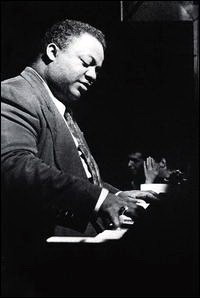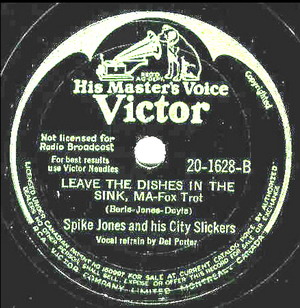|
Music, Money and Songwriters:
ASCAP and its relation to Jazz and R&B Songwriters in the 1930s
by Mark Quail
Anyone with even a passing interest in
the music business has heard stories of
musical artists not getting paid their due
for their work. There are loads of stories of the
early rock n’ rollers who had some big hits in
the fifties but ended up wasting away in some
trailer park in their later years. Those stories
are usually replete with the usual bogeymen:
the bad record companies that did not pay
royalties and the crooked managers who took
advantage of their clients.
As I read more and more about music industry
history, I noticed references to suspect dealings
that were not just from the usual suspects but
also from music industry trade groups, the
organizations that played larger overreaching
roles in the music business. Particularly an
organization called ASCAP. My investigation
into this was triggered by several comments
found in the following books:
In Peter Sylvester’s excellent work on the
history of boogie-woogie piano, he writes
regarding Meade Lux Lewis:
In 1941, after having been rebuffed by ASCAP
for a membership, famed boogie-woogie
pianist-composer Meade Lux Lewis’s cause was
picked up by Downbeat Magazine. Mr. Lewis
was the composer of such songs as “Yancey
Special” and “Honkey Tonk Train Blues”, both
of which were commercial hits and sold over
500,000 records. Downbeat printed articles
about the situation in 1942 and eventually
embarrassed ASCAP into allowing him to join.
Reasons for the refusal were never given and it
can only be guessed that it was either another
manifestation of the "Jim Crow” mentality
discrimination against Lewis, or a misguided
view that boogie-woogie compositions were not
taken seriously as music. [1]

|
|
Meade Lux Lewis
|
|
|
Mark Coleman hints further at what was going
on at the time in his book on the history of the
music industry:
Formed in 1939, BMI emerged as ASCAP’s
eager sibling, younger and hungrier. BMI
existed to service the needs of local radio
stations and at the same time promote regional
music. BMI also lifted the bar on song
publishing: the list opened up to small-label
performers – that is, "hillbilly” and black
– which’d been excluded by ASCAP. [2]
Finally, in Rick Coleman’s vivid biography of
Fats Domino, he comments about events in the
1930s when writing, "… the exorbitant royalty
demands of the music publishing monopoly
ASCAP, led the radio networks to form BMI
which, in sheer desperation for songwriters, did
not discriminate.”[3]
Discrimination? Exclusion? Refusal? "What
was going on here?” I asked myself as I set
out to investigate. Who or what was ASCAP?
Well, ASCAP is the acronym for the American
Society of Composers Authors and Publishers.
They are a trade organization of music
publishers. They function to license music
and collect royalties arising from the public
performance of music, whether that be live
performance or performance on TV or radio.
BMI is a similar-styled organization. They are
organized to collect the same type of music
royalties. Their acronym stands for Broadcast
Music Inc.
So, how and why did ASCAP Start? [4] At the
end of the 19th Century, in the United States,
the owners of music copyrights, called "music
publishers” (because they printed sheet music
containing versions of their songs), were having
a hard time fighting people who counterfeited
their sheet music. In 1889, the US Copyright
Act was amended to provide for the payment of
royalties for the performance of music. It was
seen as a way to protect music publishers from
counterfeit sheet music because it focused on
the value of the performance of the music, not
just its worth on the printed page. But it was
only a law in concept as there was no real way
to enforce it. Yet.
In New York City, which was then the centre
of the North American music business,
the Witmark boys – a five-brother team of
songwriters, music printers and publicists - had
built themselves into one the leading music
publishing companies in the USA. They and
several other music publishers came together in
February 1914 to form the American Society of
Composers, Authors and Publishers (ASCAP).
Their purpose was to issue licenses and collect
royalties from those who performed music in
public. This was the new stream of income,
separate from the other monies that could be
earned from owning songs.
They based their model on a European system
where cabarets, night clubs and other public
venues were required to pay a fee for a license
that allowed those places to play the music
publishers’ music in their venues. After
deducting an operating fee, the organization
would then distribute collected royalties directly
to member
publishers and
composers. Their
key to success
was to enlist the
participation of
all venues from
the smallest to the
largest. This was
a time-consuming
project and an
area where much
energy was
expended.

|
|
This early 1940s Victor label clearly
asserts that the recording was "Not Licensed for Radio Broadcast"
|
|
|
As the years went
on, however,
there was a
technological
development happening that would take up
even more of their time and energy. The dawn
of radio and programs that played music on the
radio posed a new set of problems for ASCAP
in the 1920s. The station owners/broadcasters
simply refused to pay ASCAP in order to
play their members’ music. The broadcasters
believed that, once they had purchased the
record, they were free to play it all they wanted
because they owned the physical copy. The
broadcasters also believed that the fee ASCAP
sought was too high.
This battle raged through the twenties and
in to the late 1930s with the broadcasters
successfully rebuffing ASCAP’s attempts to get
money out of them. ASCAP finally issued a
threat to the broadcasters: pay us for using our
music or stop playing our music altogether.
The broadcasters responded by forming their
own performing rights organization, "BMI”, in
1939. BMI then agreed with the broadcasters
on a rate for the performance of its music on
radio. Now BMI had to acquire some content.
Because ASCAP controlled the great majority
of American popular music, BMI was forced to
look to the musical fringes for its members.
To better understand what was going on at
the time, it’s important to know that ASCAP
represented songwriters like Cole Porter, George Gershwin
and Irving Berlin.
They considered
their writers
to be the true
representatives of
America’s music
and therefore
"society’s”
rightful "popular”
music. ASCAP
basically ignored
all the music that
"society” associated with the unsophisticated
classes and "degenerates”. They made it very
hard for jazzmen, country fiddlers, Appalachian
musicians and blues singers to obtain
membership in their organization.
With the formation of BMI, because the new
organization needed music for broadcast
purposes, they opened their doors to a wider
selection of musicians.
As a result of the broadcasters forming BMI,
ASCAP went ballistic and announced that as of
December 31, 1940, they would press charges
against any radio station that broadcast ASCAPlicensed
music without paying the licensing
fee. The penalty for copyright infringement for
failing to pay royalties at that time was $250 for
each time a song was played.
The broadcasters responded, as one would
expect: they simply revised their play-lists to
include only BMI-licensed songs. Overnight,
all the George Gershwin, Hoagy Carmichael
and Harry Warren songs vanished from the
airwaves. And what happened?
Nothing. The broadcasters discovered that
the American radio-listening public had no
problem with the new content and there was
no decline in the audience. So with continuing
revenues based on the revised play-lists, the
broadcasters continued to invest in BMI. BMI
offered equitable, fair contracts to interested
songwriters. They made it easy to join, as they
did not require that a songwriter already have
published at least 5 songs, as ASCAP did.
At the same time, other dramatic events were
unfolding. In the summer of 1940, a suit was
instigated by the U.S. Justice Department
that accused ASCAP of restraint of trade,
monopolistic tactics, and discrimination against
non-members. It was this suit that finally
succeeded in bringing ASCAP to its negotiating
knees. Twenty-six years of doing battle with
station owners had drained the organization’s
finances and had broken its morale. Finally, in
November 1941, the organization was forced
to settle for the same two and three-fourths
percent of the radio stations’ annual advertising
revenues, a proportion that the stations had
willingly given BMI, far below the seven and a
half percent that ASCAP had always demanded
but had never received.

|
|
James Petrillo
|
|
|
There were those who saw in the settlement
a major victory for ASCAP, which had never
before earned so much as one cent in broadcast
royalties. Others saw it as a pyrrhic victory, for
ASCAP’s hard line of negotiation had brought
about the existence of BMI, whose roster of
talent signalled to many the beginning of the
end of the commercial music business’s (Tin
Pan Alley’s) golden era.
Yet, this is not the end of the story, as there
arose some unintended repercussions. The
radio broadcast industry initially provided a lot
of jobs for live musicians to play in the radio
shows. The settlement between the broadcasters
and ASCAP now meant that radio had a lot
of pre-recorded content to choose from. Prerecorded
content was less expensive to air but
meant fewer opportunities for live musicians
to play. This rankled the powerful musicians
union, the American Federation of Musicians,
to no end. And so, in 1942, James Petrillo,
the president of the AFM, called a strike and
pulled the Federation’s musicians out of all
recording studios to prevent the manufacture
of new records. Petrillo had been looking for a
way to break the back of the recording industry
for some time and this settlement with the
broadcasters pushed him to draw the line in the
sand.
On August 1, 1942, the strike went into effect
and effectively halted the manufacture of any
new records. Because of this, many blues, folk
and jazz musicians (who would more than likely
have been BMI members) were prevented from
recording. ASCAP publishers, however, had a
banner year in 1943 because record companies
had a huge backlog of unsold disks containing
ASCAP-licensed songs that they re-released
during the strike.
This was a short-term problem, however. By
the mid-1950s, 80 percent of all music played
on the radio was licensed by BMI. But the
tale of music in North America after WWII is
another story for another day.
And what of these performance rights societies?
ASCAP and BMI are big business still
today and luckily the restrictive membership
application practices have disappeared.
Footnotes
Silvester, Peter: A Left Hand Like God: The
Story of Boogie Woogie. London: Omnibus
Press 1990 at 165 to 166
- Coleman, Mark. Playback – From the
Victrola to MP3, 100 Years of Music, Machines,
and Money. Cambridge: Da Capo Press. 2003
at 46
- Coleman, Rick: Blue Monday – Fats
Domino and Lost Dawn of Rock ‘n’ Roll.
United States: Da Capo Press 2006 at 3 to 4.
- The bulk of the story from this point
forward comes from media business author
Marc Eliot’s fascinating book "Rockonomics".
Eliot, Mark: Rockonomics – The Money
Behind The Music. New York: Citadel Press,
1989
|